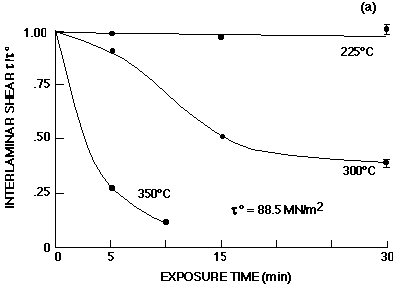While researching my material on epoxy and temperature, I came across an
interesting comment. It is not verified in any way and I am not sure if it is
true, it may even be from an outdated source, but goes something like this:
From "Construction Notes" Falco Builders Letter, September 1992
Stuart Gane was alarmed to discover a warning that West System 410 Microlight
filler is sensitive to elevated temperatures and that the material can swell
when hot. Stuart writes, "I have been informed by Brian Knight of Gougeon Bros
that the filler is probably going to be OK in the temperate climate of the UK,
if I were to paint my Falco red. However, he did warn me that if I were to fly
my aircraft to, say, the Mediterranean or wherever the air temperature exceeded
the 70-80°F range, I could expect the sanding marks left by the rubbing-down
process to show through the paint or, even worse-where there is a substantial
thickness of Microlight filler-a swelling of the filler could occur, because
the filler is a thermoplastic material. Only light colors would overcome this
problem." Glass and phenolic microballoons are not affected in this way.
Is there anything in the class rules that prohibits using vast quantities of
410 and then sailing in the heat to achieve more bouyancy when it swells
up..... LOL. I think that my sailing style is going to be really beneficial
here, because I get my deck completely wet every five minutes or so.
----- Original Message -----
From: Greg Ryan
To: rowr ; swiftsolo@xxxxxxxxxxxx
Sent: Wednesday, February 02, 2005 10:04 AM
Subject: Re: Epoxy and bolts
Fabulous practical observation Roger, Thanks.
But, do you really mean Celsius not Fahrenheit? 120-130F is only 48.8-54.4C
Im guessing the bolt might need to be quite a bit hotter than that. Im fairly
confident that my black 49er mast has been much hotter than that over a long
period and many cycles and its stiffness (which is obviously functionally
measurable) has not changed all that much. So Swift builders need not bee too
anxious that your new boat will melt if you spill a cuppa tea on the deck. I
regularly autoclave my epoxy containing instruments at work so I am interested
in this phenomenon from another angle.
The degradation in properties of advanced composites, such as graphite/epoxy,
by exposure to elevated temperatures is a concern also of NASA.
Here is some info I dug up and I'm selectively paraphrasing here -
Studies have shown that Graphite/epoxy composite materials exposed to
temperatures in the range of 177 C to 232 C (350 F to 450 F) can affect the
resin matrix sufficiently to degrade the mechanical properties.
In the temperature range below about 177 C (350 F), the dynamic modulus, G*,
as a function of strain amplitude were seen to be within the viscoelastic
range. Although there is also some evidence of changes in the range of 50C to
177C, (chemical changes that im sure cannot be reversible) extreme aging at
temperature (10,000 hours at 121 C) studies have shown mixed results with some
graphite/epoxy laminate schedules exhibiting sheer strength decreases of up to
68% and yet other graphite/epoxy laminates increased in their sheer strength(up
to 32%).
References available if anyone is interested.
Figure 6. Interlaminar Shear Strength as a Function of Temperature and
Exposure Time
Greg
----- Original Message -----
From: rowr
To: swiftsolo@xxxxxxxxxxxx
Sent: Wednesday, February 02, 2005 9:03 AM
Subject: Epoxy and bolts
If you inadvertently let some epoxy get into a hole and then forgot to
take the bolt or screw out, chances are, the bolt is in there for good. Even an
easy out will battle to remove the bolt.
SO, by this stage, you have already stripped the bolt head and cannot drill
it out because then you will drill into your T-nut which is already in your
beautifully sealed hull......
Here is a little tip for getting a bolt out . Epoxy starts getting soft at
about 120- 130F, so much so that there is a large debate going on in the
homebuilding aircraft market about using epoxy on wings, then painting the
aircraft black. Some manufacturers are suggesting that they paint all aircraft
a light colour if they live in a hot zone of the world. The results of a black
aircraft sitting in the tropical sun and then taking off with gooey wings could
be ... interesting.
Anyway, back to getting the bolt out. Take a very small size DULL drill bit
and drill into the centre of the bolt. This will heat the bolt up to such an
extent that the epoxy will soften enough to remove the bolt with a pair of
pliers.
happy building
Roger
|
